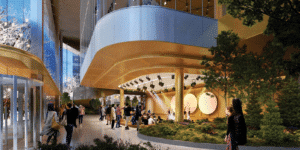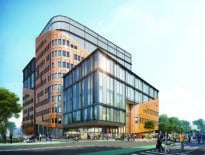
BioMed Realty’s 585 Third St. building, under construction in Cambridge’s Kendall Square, was designed with an arts center, an indoor garden and a “commons” on its ground floor, plus two large terraces at higher levels in the tower. Image courtesy of CBT Architects
The life science industry exists to improve our lives – through research, development and a healthy dose of innovation and creativity. It’s counterintuitive, then, that the lab spaces – where life-enhancing discoveries are made – are often designed only to support the work itself, not the employees who are so integral to these discoveries.
Life science R&D cannot be done at home, so many employees spend most of their weeks in these lab and office buildings. When designing new workspaces, real estate developers and biotech employers ought to adopt a holistic approach centered around the well-being of their employees. The war for talent is tough, especially in and around Boston and Cambridge, so investments in employee wellness, company culture and local communities can make a big difference in employee acquisition and retention.
Employee Wellness and Convenience
Health and wellness are at the heart of the life science industry, and life science workspaces should reflect that.
Cultivating an environment where employees can incorporate fitness into their daily routines is a major perk and one that not only increases health but also employee productivity. These spaces shouldn’t be an afterthought. Having spa-like facilities on-site emphasizes your commitment and care for employees.
And however, your employees are getting there, your workplace should be designed to support any and all commuting options. Accessible bike docking, car parking and electric vehicle charging stations remove friction from daily commutes and easy access to public transportation – where available – is critical. Beyond improving the employee experience, crafting spaces that cater to various commuting needs can also align with your ESG goals and objectives.
Also, healthy and reliable buildings are a subtle, yet arguably more important, focus for life science real estate. Ensuring impeccable air quality and hygiene standards is an indispensable requirement for promoting the health and wellness for employees. Similarly, safeguarding buildings from unpredictable environmental factors and events, such as heatwaves and flooding, is not only a means to protect your community but also to safeguard your real estate investment well into the future.
Company Culture and Productivity
Amenities are a great way to foster a strong company culture of connection and productivity to keep employees happy, fulfilled and focused.
When creating culture-supporting amenities, think about providing space for connection, socialization and enjoyment. Life science real estate should offer mixed-use gathering spaces that harness the natural beauty of a building’s surroundings, whether indoors, outdoors, or a harmonious blend of both.
One way of creating organic gathering spaces is through robust food and beverage offerings for tenants to enjoy; whether it’s a cafe for a quick coffee run or a gastropub for post-work socialization, these options will go a long way in elevating a space and adding to tenants’ happiness. Engaging local retail and restaurant operators to manage these spaces also offers a great opportunity to support local small businesses, while also ensuring that the space has a authentic look and feel.
(sub)Community Involvement
Each and every community is unique in some capacity, from nearby small businesses and community organizations to environmental features and popular recreational activities. Whatever the nuances, nearby workspaces should harmonize with the local community where they are situated. Outdoor spaces should exude a welcoming and inclusive vibe, allowing public access, while properties should seamlessly integrate into the community rather than isolating themselves from it.

Sal Zinno
Within life science real estate development, there is a tremendous opportunity to bring life to your corner of the neighborhood by hosting seasonal pop-ups with local artisans, chefs or outdoor activities, support nearby nonprofits by providing them with rent-free space or host fundraising events for them, and so on. While your lab and office buildings should undoubtedly make a statement, biotech companies and their employees can truly thrive within dynamic, vibrant communities that remain active well beyond the typical close of business hours.
Life science spaces should mirror the innovation, company culture and community fabric of the brilliant individuals operating within them. Workplace amenities are a key way of getting there – and biotech leaders should prioritize amenities that cater to the holistic well-being of their employees when exploring options for lab space. The fight for talent is fierce, and going beyond simply providing R&D space and a parking pass for employees can go a long way toward attracting and retaining the best and brightest.
Sal Zinno is senior vice president for development in the East Coast and U.K. markets at BioMed Realty






